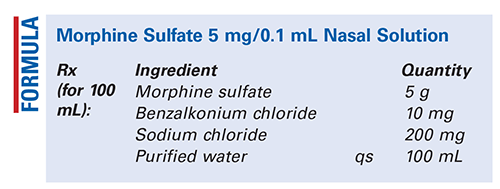US Pharm. 2022;47(3):59-60.

Method of Preparation: Calculate the required quantity of each ingredient for the total amount to be prepared. Accurately weigh or measure each ingredient. Dissolve all of the ingredients in sufficient purified water to final volume and mix well. Package in a calibrated nasal-spray container that delivers 0.1 mL per squeeze (i.e., activation).
Use: This preparation is used in the treatment of moderate-to-severe pain. The dose is easily adjusted depending on the number of activations, or squeezes, administered.
Packaging: Package in tight, light-resistant containers.
Labeling: Keep out of reach of children. Discard after ____ [time period].
Stability: A beyond-use date of up to 30 days may be used for this formulation as a topical preparation.1
Quality Control: Quality-control assessment can include weight/volume, pH, specific gravity, active drug assay, color, clarity, rheologic properties/pourability, physical observation, physical stability (discoloration, foreign materials, gas formation, mold growth), and preservative-effectiveness test.2,3
Discussion: Morphine sulfate has been used for decades to treat moderate-to-severe pain. The advantage of this dosage form is that the dose to be administered can be easily changed based on the number of squeezes of the calibrated nasal-spray container.
Morphine sulfate ((C17H19NO3)2·H2SO4·5H2O, MW 758.83) is a phenanthrene-derivative opiate agonist used in the treatment of severe acute pain or moderate-to-severe chronic pain. It is odorless and occurs as white, feathery, silky crystals; cubical masses of crystals; or a white, crystalline powder. Morphine sulfate gradually loses water of hydration when exposed to air, and it darkens on prolonged exposure to light. Morphine sulfate is soluble in water, freely soluble in hot water, and slightly soluble in alcohol. It is available as injections, solutions, suppositories, and tablets, and as extended-release oral capsules and tablets.1
Benzalkonium chloride is a bactericidal antimicrobial agent commonly used as a preservative in many ophthalmic, otic, nasal, and parenteral formulations. It occurs as a white or yellowish-white amorphous powder, a thick gel, or gelatinous pieces/flakes with a characteristic mild aromatic odor, soapy touch, and very bitter taste. Benzalkonium chloride is highly soluble in water, alcohol, and acetone. It is hygroscopic, and a 10% w/v aqueous solution has a pH in the range of 5 to 8. Benzalkonium chloride is composed of a mixture of straight-chain homologues that possess different physical, chemical, and microbiologic properties. The proportions of these homologues in the mixture determine its effectiveness as a preservative and disinfectant. As a preservative in ophthalmics, benzalkonium chloride is used in concentrations from 0.004% to 0.02%, with the 0.01% concentration being common.1,4
Sodium chloride (NaCl, MW 58.44) is available as a white, crystalline powder and colorless crystals with a saline taste. It is used in a variety of parenteral and nonparenteral pharmaceutical formulations. In parenteral, ophthalmic, and nasal preparations, sodium chloride is used to prepare isotonic solutions. It is also used as a capsule diluent and as a lubricant; to control drug release from some microcapsules and to control micelle size; and to adjust the viscosity of some polymer dispersions by altering the ionic character of the formulation. The pH of a saturated solution ranges from 6.7 to 7.3, and it is soluble in water (1 g in 2.8 mL), glycerin (1 g in 10 mL), and 95% ethanol (1 g in 250 mL). A 0.9% w/v aqueous solution is iso-osmotic with serum, and its solutions are stable.5
Purified water is water that is obtained by distillation, ion exchange, reverse osmosis, or another suitable process. Water has a specific gravity of 0.9971 at room temperature, a melting point of 0°C, and a boiling point of 100°C. It is miscible with most polar solvents and is chemically stable in all physical states (ice, liquid, and steam).6
REFERENCES
1. U.S. Pharmacopeia/National Formulary [current revision]. Rockville, MD: U.S. Pharmacopeial Convention, Inc; February 2022.
2. Allen LV Jr. Summary of quality-control testing for sterile and nonsterile compounded preparations, part 1: physical and chemical testing. IJPC. 2019;23(3):211-216.
3. Allen LV Jr. Summary of quality-control testing for sterile and nonsterile compounded preparations, part 2: microbiological testing. IJPC. 2019;23(4):299-303.
4. Kibbe AH, Quinn ME. Benzalkonium chloride. In: Sheskey PJ, Hancock BC, Moss GP, Goldfarb DJ, eds. Handbook of Pharmaceutical Excipients. 9th ed. London, England: Pharmaceutical Press; 2020:132-135.
5. Watters M. Sodium chloride. In: Sheskey PJ, Hancock BC, Moss GP, Goldfarb DJ, eds. Handbook of Pharmaceutical Excipients. 9th ed. London, England: Pharmaceutical Press; 2020:945-949.
6. Dubash D, Shah U. Water. In: Sheskey PJ, Hancock BC, Moss GP, Goldfarb DJ, eds. Handbook of Pharmaceutical Excipients. 9th ed. London, England: Pharmaceutical Press; 2020:1111-1115.
The content contained in this article is for informational purposes only. The content is not intended to be a substitute for professional advice. Reliance on any information provided in this article is solely at your own risk.
To comment on this article, contact rdavidson@uspharmacist.com.





